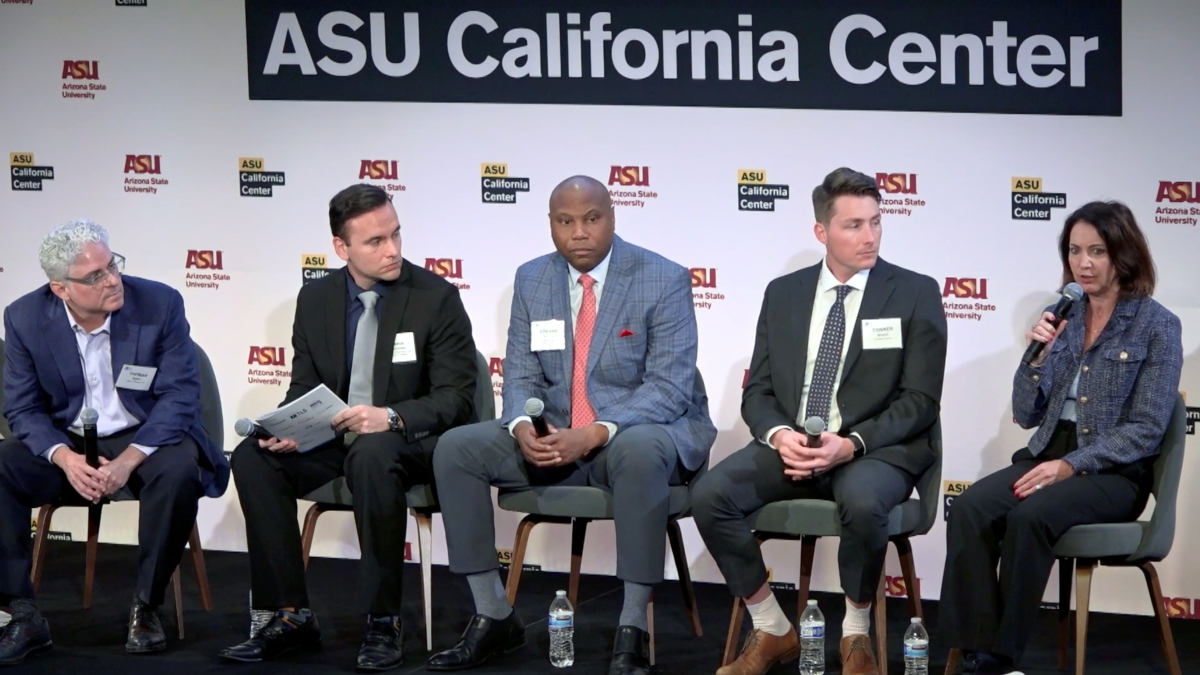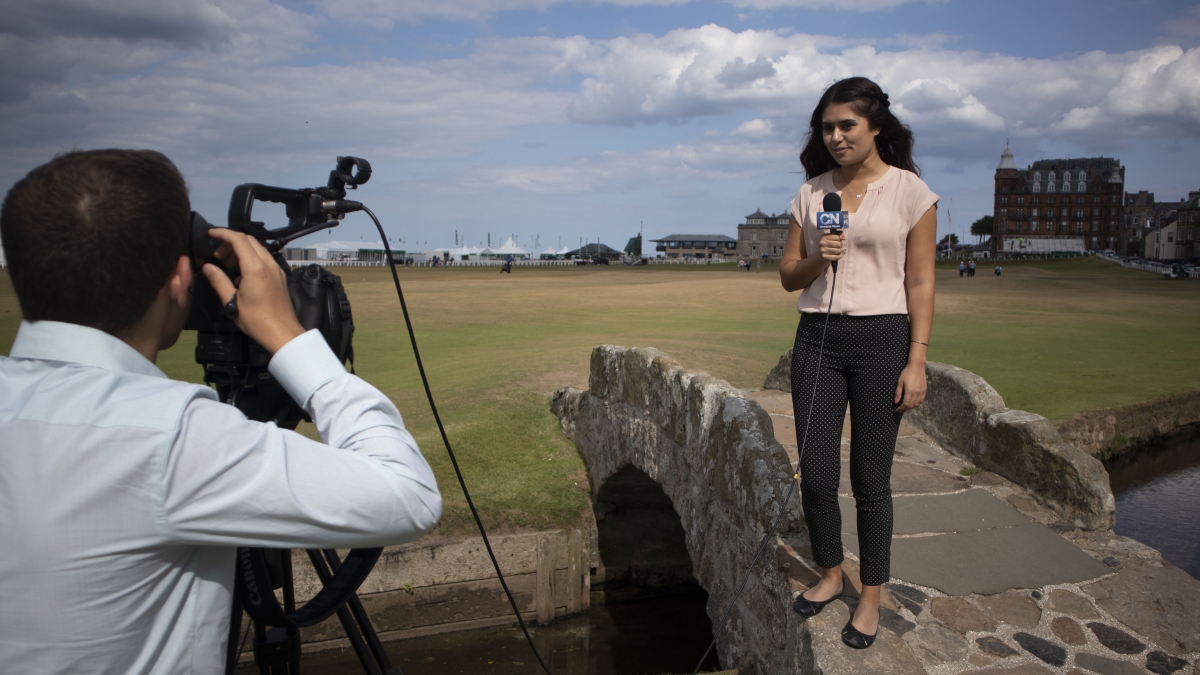Fourteen days. Twelve students. Seven cities. One memorable trip, and lots of cool stories. And there was haggis, too … fore everyone.
A dozen students from the Walter Cronkite School of Journalism and Mass Communication at Arizona State University recently ventured to Scotland for an immersive study-abroad program that had them studying golf’s roots while honing their journalism skills and learning about a new culture.
“We wanted to create a news operation in a foreign country but also provide a one-of-a-kind opportunity that helps students gain valuable experience while putting something on their resumes that helps set them apart,” said Brett Kurland, director of sports programs at the Cronkite School.
The school is home to immersive professional programs in which students regularly cover professional and intercollegiate sports from bureaus in Phoenix and Los Angeles. Since the Cronkite School announced new sports journalism degrees in 2014, students have covered major sporting events, including the Super Bowl, the Summer Olympics and the NCAA Final Four.
Kurland said it’s the first sports journalism study-abroad program at Cronkite not tied to the Summer Olympics. He said his motivation for creating the trip was to increase the study-abroad opportunities available to sports journalism students beyond the Summer Games, which take place every four years. Cronkite brought students to the Summer Olympics in 2012 and 2016, and Kurland is currently working on a 2020 trip to Tokyo.
“This trip was designed to open the door to international reporting experience for more sports journalism students,” Kurland said, who led the trip along with Cronkite PhD student and faculty associate Gail Rhodes.
The group traveled to Edinburgh, Glasgow, Perth, St. Andrews, Carnoustie, Aberdeen and Gullane to discover golf’s roots and report on the nuances of the game in the country where it was born.
They tried to incorporate as much golf and Scottish culture as possible, including visiting Edinburgh Castle and eating haggis their first night on the town.
“You know, it wasn’t that bad,” said Drake Dunaway, a 24-year-old graduate student. “It gets a bad rap. Pretty much like the American hot dog.”
Other stops included the British Golf Museum in St. Andrews, Glasgow Golf Club, the Royal Burgess Golfing Society, the St. Andrews Golf Company, the Scottish Open, the British Open, and the Old Course at St. Andrews, arguably the most iconic golf course in the world. They also met with the Golf Environment Organization, which pursues sustainability in and through golf, as well as members of the NBC and Golf Channel crew in the 18th tower at the British Open on the Monday of tournament week.
For this trip, students were required to write or produce one enterprise story or video, and report daily short photo stories that were shared via Instagram. Kurland said the idea was to identify compelling people and sources for each post, which included a quote and a photo to help tell their story. He said the ultimate goal was to capture the entire picture and essence of each location.
“The idea was to find real-life characters and tell their stories,” Kurland said.
Sports journalism major Scotty Gange, 19, said he produced a story in Edinburgh on Bruntsfield Links, located just outside the front door of the Golf Tavern, the oldest golf clubhouse in the world, tracing its roots back to 1456. He said he learned about the two places through an Edinburgh city guide.
“It’s a 36-hole chip and putt course located in the middle of the city near the University of Edinburgh,” Gange said. “You pay five pounds and get a chipping wedge and putter. Students, in groups of usually 20, go there, have beers and play golf. It’s a way for them to relax.”
Gange said he didn’t know much about golf before the trip, but now he has much more respect for the sport and the complexity of filming a major golf tournament.
“With football and basketball, there’s one ball, one field or court,” Gange said. “With a golf open, there’s 144 players, 144 balls all playing in the span of about five hours. Seeing that unfold from a broadcaster’s perspective was eye-opening.”
Dunaway covered a story that has been plaguing golf around the world: How to invigorate the sport with newcomers.
“Memberships are down and the younger generation either doesn’t have the time or money, or would rather spend their money on other things that aren’t as time consuming or cost as much,” Dunaway said. “They are trying to reverse this trend.”
Dunaway visited courses and golf societies that are coming up with initiatives such as shorter courses, playing tee forward, team formation and prizes, no golf fees for players under 18 and speeding up the game.
Student Nicholas Welter took an old-school approach to his story and reported on the manufacturing of wooden clubs at the St. Andrews Golf Company. According to Welter, the manufacturer dates back to 1881 and is the only Scottish company still producing these special clubs, which retail anywhere from 90 to 300 British pounds per club.
“It’s a niche thing and the wooden clubs are made of hickory,” Welter said. “They’re mostly manufactured as collector’s pieces, and players still compete in hickory tournaments throughout the world,” said Welter, a 20-year-old senior.
In addition to Dunaway, Gange and Welter, other student journalists on the trip included Mark Feldman, Carson Field, Logan Huff, Daniel Karl, Madison Kerley, Kynan Martin, Evan Millstein, Katie Thomas and Will Tyrell.
To learn more about the 250-plus study-abroad programs in more than 65 different countries offered at ASU, see the Study Abroad Office website. Visit the Study Abroad Expo from 11 a.m. to 2 p.m. Aug. 22 in the Ventana Ballroom of the Memorial Union to learn more about programs and scholarships.
Top photo: Cronkite journalism student Madison Kerley tapes a segment for Cronkite News on the Swilken Bridge at the St. Andrews Links golf course in St. Andrews, Scotland. Kerley was one of a dozen students who went to Scotland on a study-abroad program that looked at the birthplace of golf. Photo courtesy of Brett Kurland
More Law, journalism and politics

TechTainment conference explores the crossroads of law, technology, entertainment
What protections do writers, actors, producers and others have from AI? Will changing laws around name, image and likeness (NIL) eliminate less lucrative college sports?And what does the No…

How to watch an election
Every election night, adrenaline pumps through newsrooms across the country as journalists take the pulse of democracy. We gathered three veteran reporters — each of them faculty at the Walter…
Law experts, students gather to celebrate ASU Indian Legal Program
Although she's achieved much in Washington, D.C., Mikaela Bledsoe Downes’ education is bringing her closer to her intended destination — returning home to the Winnebago tribe in Nebraska with her…
